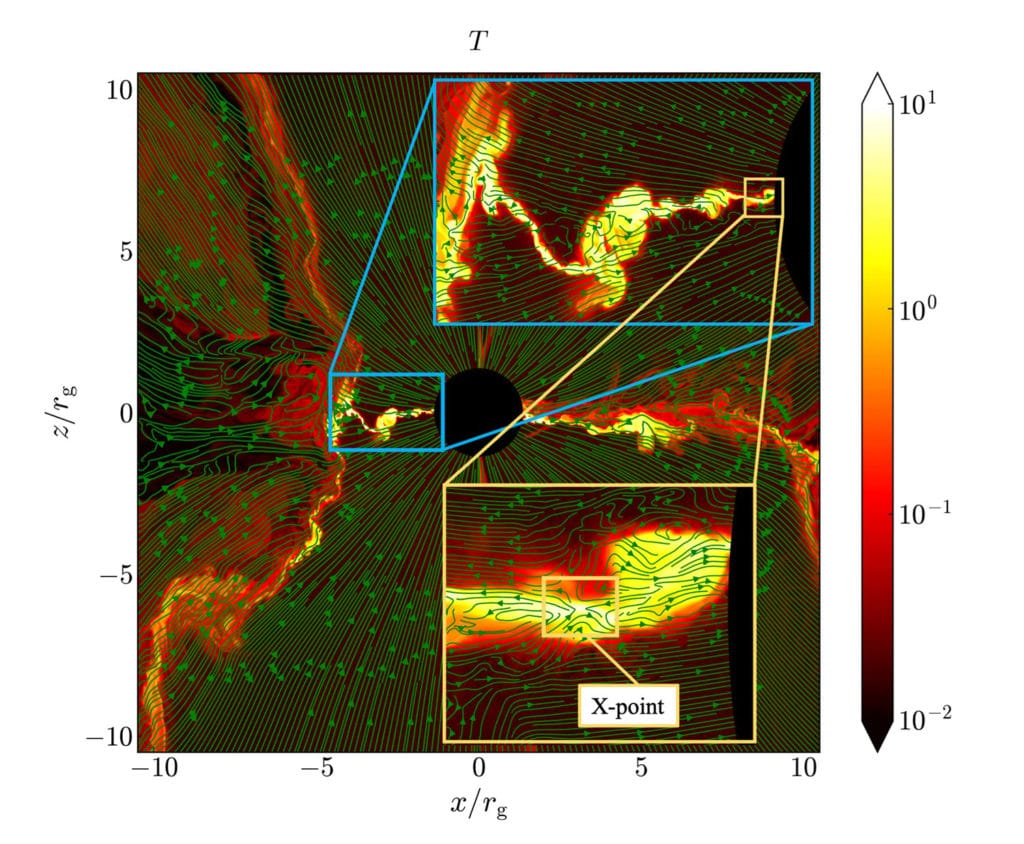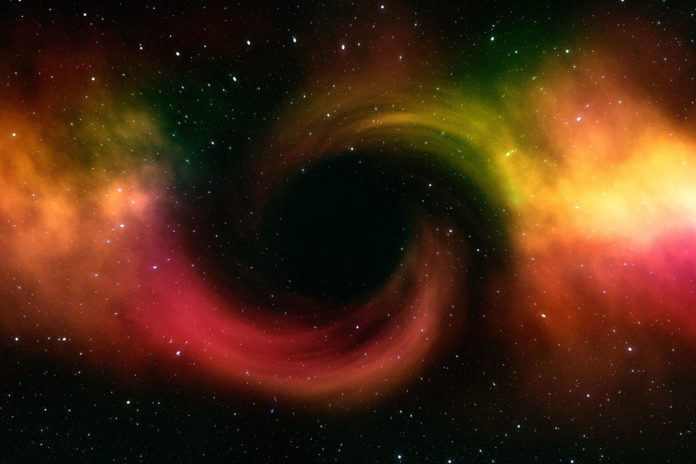Supermassive black holes don’t give off light themselves, but they are known to emit flares periodically. These flares are shining from just outside the event horizon of supermassive black holes.
Astronomers regularly watch black holes flare, but how this happens remains elusive. Identifying where the flares form in a black hole’s anatomy is incredibly difficult. Previous studies using powerful computers could only simulate black hole systems at resolutions too low to see the mechanism that powers the flares.
Now, astrophysicists from Simons Foundation reported that they had solved this mystery. They used computer simulations of unparalleled power and resolution to identify the mechanism that powers black hole flares. They found that the energy released near a black hole’s event horizon during the reconnection of magnetic field lines powers the flares.
The new simulations show that interaction between the magnetic field and material falling into the black hole makes the field compress, flatten, break and reconnect. That cycle eventually utilizes magnetic energy to slingshot hot plasma particles at close to light speed into the black hole or out into space. Those particles can then directly transmit away a portion of their kinetic energy as photons and give nearby photons an energy boost. Those energetic photons make up the mysterious black hole flares.

In this model, the disk of previously infalling material is ejected during flares, clearing the region around the event horizon. This cleaning up could give astronomers an unhindered view of the usually obscured processes just outside the event horizon.
Study co-lead author Bart Ripperda, a joint postdoctoral fellow at the Flatiron Institute’s Center for Computational Astrophysics (CCA) in New York City and Princeton University, said, “The fundamental process of reconnecting magnetic field lines near the event horizon can tap the magnetic energy of the black hole’s magnetosphere to power rapid and bright flares. This is really where we’re connecting plasma physics with astrophysics.”
The simulation that astrophysicists created was by far the highest-resolution simulation of a black hole’s surroundings ever made, with over 1,000 times the resolution of previous efforts.
Thanks to high resolution, scientists could see an unprecedented picture of the mechanisms leading to a black hole flare. The process centers on the black hole’s magnetic field, which has magnetic field lines that spring out from the black hole’s event horizon, forming the jet and connecting to the accretion disk.
The simulations also show how the magnetic field between the flowing material and the black hole’s jets intensifies, squeezing and flattening the equatorial field lines. Those field lines are now in alternating lanes pointing toward the black hole or away from it.
When two lines pointing in opposite directions intersect, they can break, reconnect and tangle. This intersection creates a pocket in the magnetic field filled with hot plasma that either falls into the black hole or is accelerated out into space at tremendous speeds. This happens due to energy taken from the magnetic field in the jets.
Ripperda said, “Without the high resolution of our simulations, you couldn’t capture the subdynamics and the substructures. In the low-resolution models, reconnection doesn’t occur, so there’s no mechanism that could accelerate particles.”
The team also observed that the magnetic field energy wanes after the black hole flares for a while, and the system resets. Then, over time, the process begins anew. This cyclical mechanism explains why black holes emit flares on schedules ranging from every day to every year.
Ripperda thinks, “Observations from the recently launched James Webb Space Telescope combined with those from the Event Horizon Telescope could confirm whether the process seen in the new simulations is happening and if it changes images of a black hole’s shadow. We’ll have to see.”
The team is now working to improve the simulations with more details.
Journal Reference:
- B. Ripperda, M. Liska, K. Chatterjee, G. Musoke, A. A. Philippov, S. B. Markoff, A. Tchekhovskoy, Z. Younsi. Black Hole Flares: Ejection of Accreted Magnetic Flux through 3D Plasmoid-mediated Reconnection. The Astrophysical Journal Letters, 2022; 924 (2): L32 DOI: 10.3847/2041-8213/ac46a1
